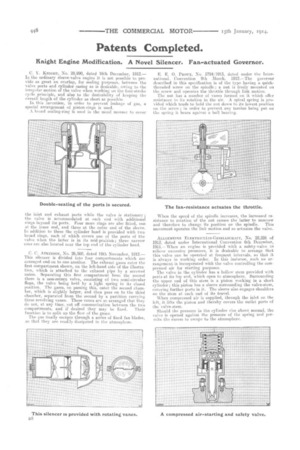Patents Completed.
Page 20

If you've noticed an error in this article please click here to report it so we can fix it.
Knight Engine Modification. A Novel Silencer. Fan-actuated Governor.
C. Y. KNIGHT, No 28,990, dated 16th December, 1912— In the ordinary sleeve-valve engine it is not possible to provide as great an overlap, for sealing purposes, between the valve ports and cylinder easing as is desirable, owing to the irregular motion ot the valve when working on the four-stroke cycle principle, and also to the desirability of keeping the overall length of the cylinder as short as possible.
In this invention, in order to prevent leakage of gas, a special arrangement of piston-rings is used. A broad sealing-ring is used in the usual manner to cover
the inlet and exhaust ports while tho valve is stationary ; the valve is accommodated at each end with additional rings beyond its ports. Four more rings are also fitted, one at the inner end, and three at the outer end of the. sleeve. En addition to these the cylinder head is provided with two broad rings, each of which covers one of the ports of the valve when the latter is in its mid-position; three narrow ones arc also located near the top end of the cylinder head.
C. C. ATKINSON, No. 26,560, dated 19th November, 1912.— This silencer is divided into four compartments which are arranged end-on to one another. The. exhaust gases enter the first compartment shown, on the left-hand side of the illustration, which is attached to the exhaust pipe by a screwed union. .Separating this first compartment from the second there is a non-return valve, consisting of two semi-circular flaps, the valve being held by a light. spring in its closed position. The gases, on passing this, enter the second chamber, which is slightly larger, and then pass on to the third chamber, separated from the second by a partition carrying throe revolving vanes. These vanes are so arranged that they do not, at any time, cut off communication between the two compartments, and if desired they may be fixed. Their function is to split up the flow of the gases. The gas finally escapes through a series of fixed fan blades, so that they are readily dissipated in the atmosphere. E. E. 0. rnoux, No. 5794/1913, dated under the International, Convention 9th March, 1912.--The governor described in this specification is of the type baying a quick. threaded screw on the spindle; a nut is freely mounted on the screw and operates the throttle through link motion.
The nut has a number of vanes formed on it which offer resistance to its rotation in the air. A spiral spring is provided wILich tends to hold the nut down to its lowest position on the screw ; in order to prevent any torsion being pot on the spring it bears against a ball bearing.
When the speed of the spindle increases, the increased resistance to rotation of the nut causes the latter to unscrew and therefore to change its position on the spindle. This movement operates the link motion and so actuates the valve.
ALLGEIMINE ELEKTRICTITS-GESELLSCHAFT, No. 28,226 of 1912, dated under International Convention 6th December, 1911.— When an engine is provided with a safety-valve to relieve excessive pressures, it is desirable to arrange that this valve can he operated at frequent intervals, so that it. is always in working order. In this instance, such an arrangement is incorporated with the valve controlling the compressed air for starting purposes.
The valve in the cylinder has a hollow stem provided with ports at its top end, which open to atmosphere.. Surrounding the upper end of this stem is a piston working in a short cylinder ; this piston has a. sleeve surrounding the valve-stem, covering further ports in it.. The sleeve also engages shoulders on the stem at each end of its travel.
When compressed air is supplied, through the inlet on the left, it lifts the piston and thereby covers the outlet ports of the valve-stem.
Should the pressure in the cylinder rise above normal, the valve is opened against the pressure of the spring and permits the excess to escape to the atmosphere.




















